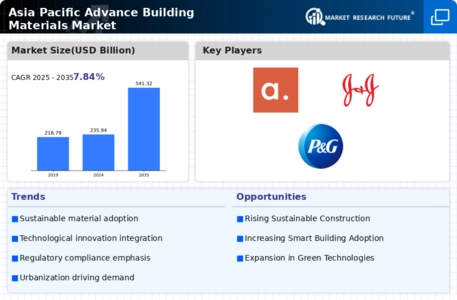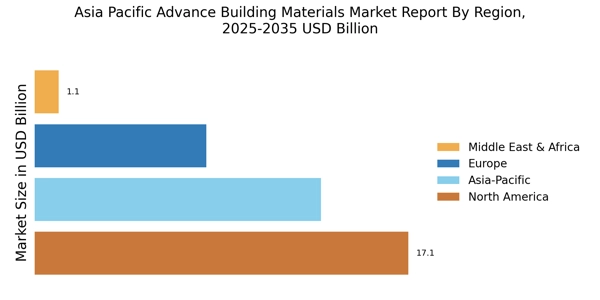Urbanization Trends
Rapid urbanization in the Asia Pacific region is a significant driver for the Advance Building Materials Market. As populations migrate to urban areas, the demand for housing and infrastructure is escalating. This urban growth necessitates the use of advanced building materials that can support high-density construction while ensuring safety and sustainability. Recent reports suggest that urban areas in Asia Pacific are expected to house over 60% of the population by 2030, leading to an increased need for innovative building solutions. Consequently, manufacturers are focusing on developing materials that cater to the unique challenges posed by urban environments, such as limited space and environmental concerns.
Sustainability Initiatives
The Asia Pacific Advance Building Materials Market is increasingly influenced by sustainability initiatives. Governments and organizations are prioritizing eco-friendly materials to reduce carbon footprints and promote energy efficiency. This shift is evident in the rising demand for materials such as recycled steel, bamboo, and low-VOC paints. According to recent data, the market for sustainable building materials in the Asia Pacific region is projected to grow at a compound annual growth rate of 10% over the next five years. This trend not only aligns with global environmental goals but also appeals to consumers who are becoming more environmentally conscious. As a result, manufacturers are innovating to create products that meet these sustainability standards, thereby enhancing their market position.
Technological Advancements
Technological advancements play a pivotal role in shaping the Asia Pacific Advance Building Materials Market. Innovations such as 3D printing, smart materials, and prefabrication techniques are revolutionizing construction processes. For instance, the integration of Building Information Modeling (BIM) allows for enhanced project visualization and efficiency, reducing waste and costs. The market is witnessing a surge in the adoption of smart materials that respond to environmental changes, thereby improving building performance. Recent statistics indicate that the market for advanced construction technologies is expected to reach USD 50 billion by 2026 in the Asia Pacific region. This technological evolution not only streamlines construction but also enhances the durability and functionality of building materials.
Government Regulations and Incentives
Government regulations and incentives are shaping the landscape of the Asia Pacific Advance Building Materials Market. Many countries in the region are implementing stricter building codes and standards aimed at enhancing safety and sustainability. These regulations often encourage the use of advanced materials that comply with energy efficiency and environmental impact criteria. Additionally, various governments are offering incentives for the adoption of green building practices, which further stimulates market growth. For example, tax rebates and grants for using sustainable materials are becoming more common. This regulatory environment not only drives innovation among manufacturers but also fosters a competitive market landscape.
Consumer Preferences for Quality and Durability
Consumer preferences are increasingly leaning towards quality and durability in the Asia Pacific Advance Building Materials Market. As awareness of building longevity and maintenance costs grows, consumers are seeking materials that offer superior performance and resilience. This trend is particularly evident in sectors such as residential and commercial construction, where the demand for high-quality materials is on the rise. Recent surveys indicate that over 70% of consumers prioritize durability when selecting building materials. Consequently, manufacturers are compelled to innovate and enhance the quality of their offerings, ensuring they meet the evolving expectations of consumers. This shift not only influences product development but also impacts marketing strategies within the industry.


















Leave a Comment